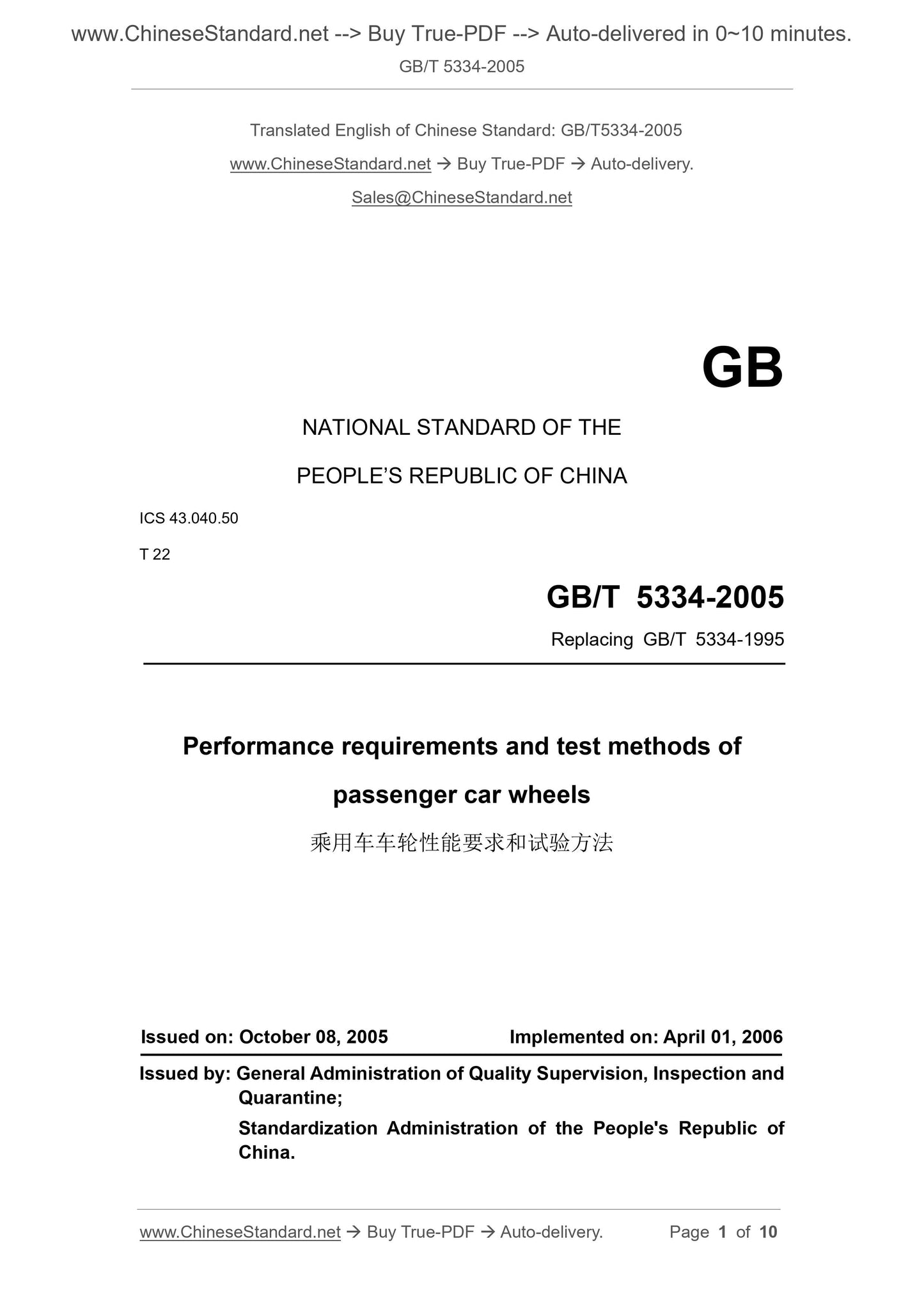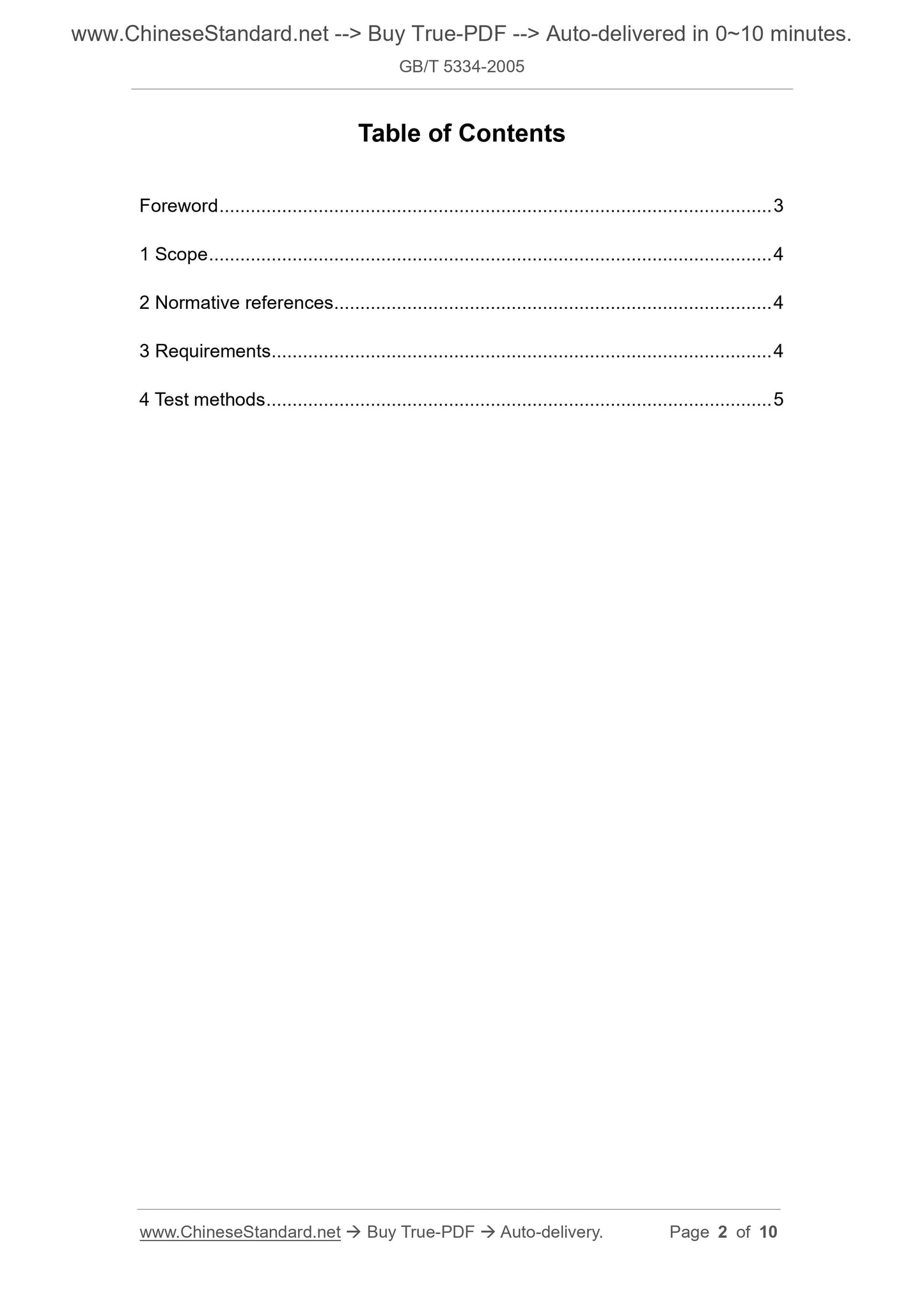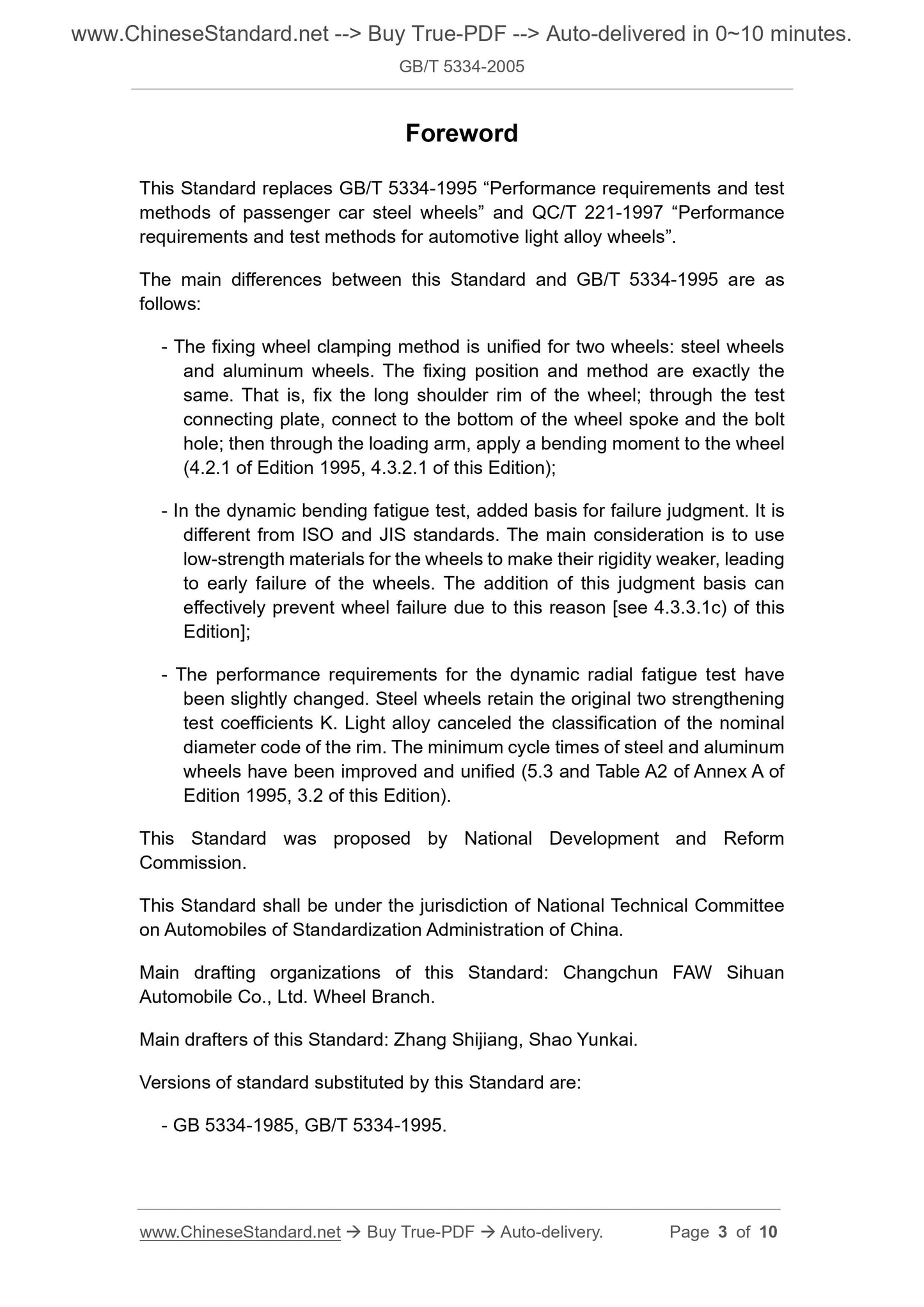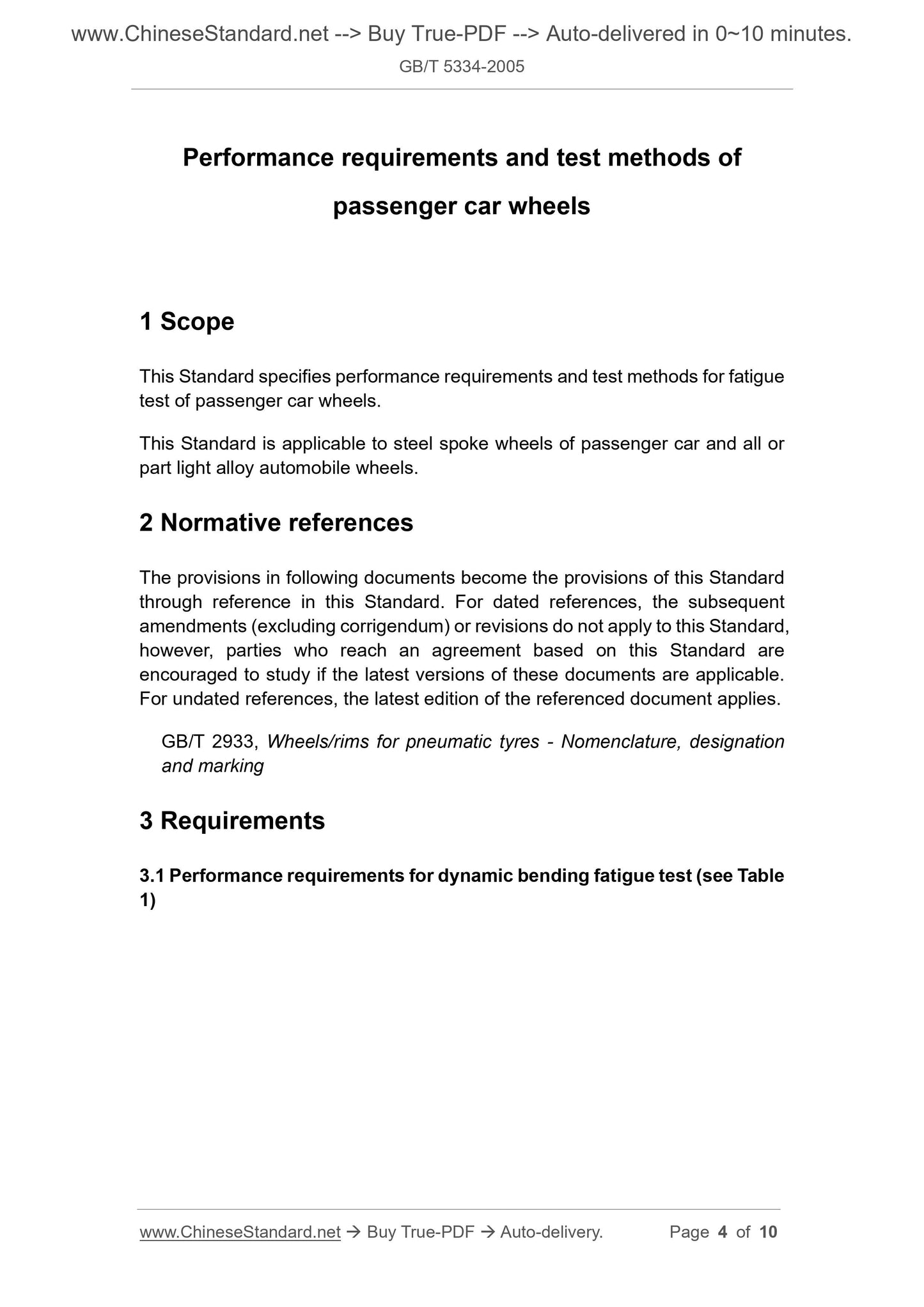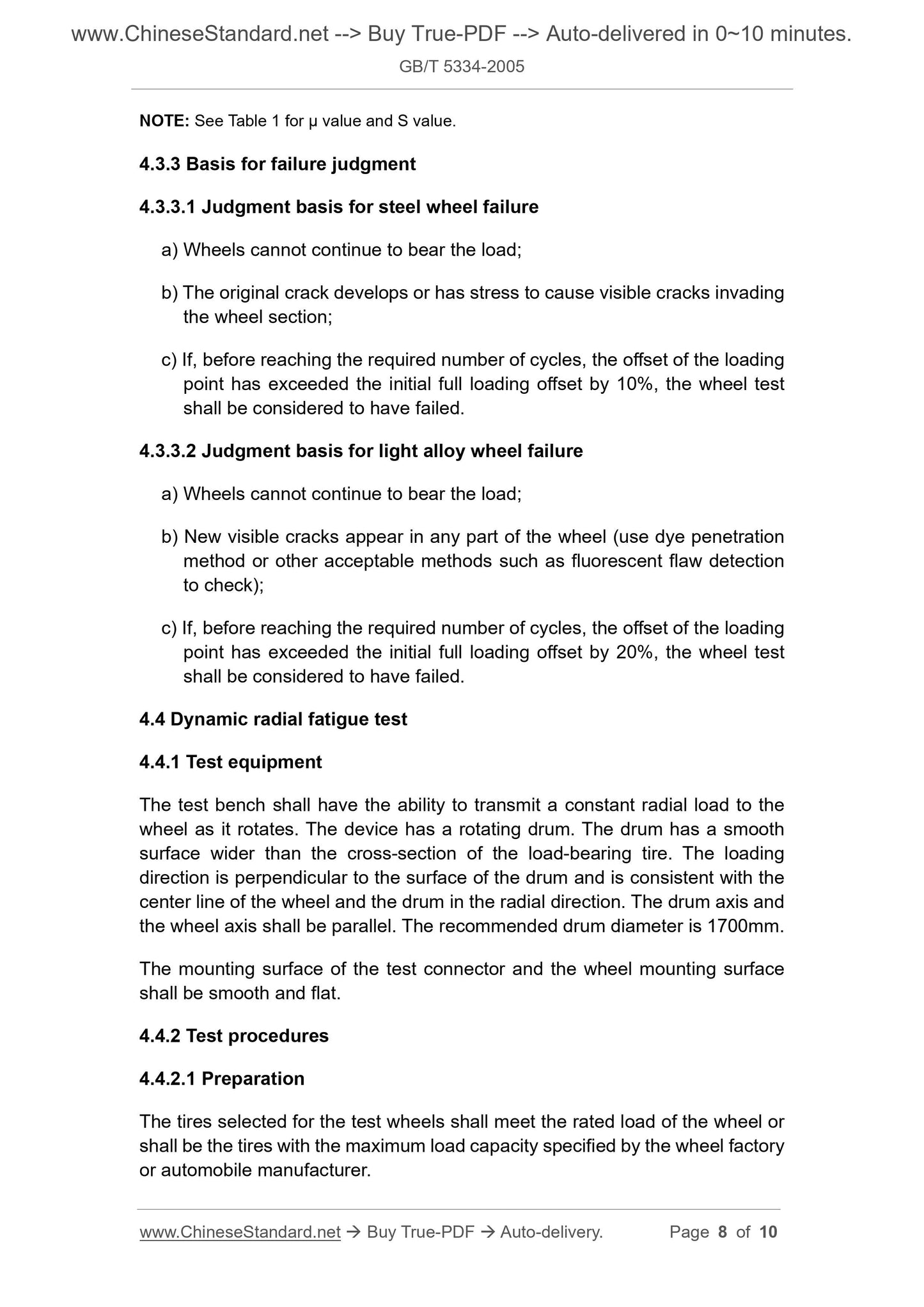1
/
of
5
PayPal, credit cards. Download editable-PDF and invoice in 1 second!
GB/T 5334-2005 English PDF (GB/T5334-2005)
GB/T 5334-2005 English PDF (GB/T5334-2005)
Regular price
$70.00
Regular price
Sale price
$70.00
Unit price
/
per
Shipping calculated at checkout.
Couldn't load pickup availability
GB/T 5334-2005: Performance requirements and test methods of passenger car wheels
Delivery: 9 seconds. Download (and Email) true-PDF + Invoice.
Newer version: (Replacing this standard) GB/T 5334-2021
Get Quotation: Click GB/T 5334-2005 (Self-service in 1-minute)
Historical versions (Master-website): GB/T 5334-2021
Preview True-PDF (Reload/Scroll-down if blank)
GB/T 5334-2005
GB
NATIONAL STANDARD OF THE
PEOPLE’S REPUBLIC OF CHINA
ICS 43.040.50
T 22
Replacing GB/T 5334-1995
Performance requirements and test methods of
passenger car wheels
ISSUED ON: OCTOBER 08, 2005
IMPLEMENTED ON: APRIL 01, 2006
Issued by: General Administration of Quality Supervision, Inspection and
Quarantine;
Standardization Administration of the People's Republic of
China.
Table of Contents
Foreword ... 3
1 Scope ... 4
2 Normative references ... 4
3 Requirements ... 4
4 Test methods ... 5
Foreword
This Standard replaces GB/T 5334-1995 “Performance requirements and test
methods of passenger car steel wheels” and QC/T 221-1997 “Performance
requirements and test methods for automotive light alloy wheels”.
The main differences between this Standard and GB/T 5334-1995 are as
follows:
- The fixing wheel clamping method is unified for two wheels: steel wheels
and aluminum wheels. The fixing position and method are exactly the
same. That is, fix the long shoulder rim of the wheel; through the test
connecting plate, connect to the bottom of the wheel spoke and the bolt
hole; then through the loading arm, apply a bending moment to the wheel
(4.2.1 of Edition 1995, 4.3.2.1 of this Edition);
- In the dynamic bending fatigue test, added basis for failure judgment. It is
different from ISO and JIS standards. The main consideration is to use
low-strength materials for the wheels to make their rigidity weaker, leading
to early failure of the wheels. The addition of this judgment basis can
effectively prevent wheel failure due to this reason [see 4.3.3.1c) of this
Edition];
- The performance requirements for the dynamic radial fatigue test have
been slightly changed. Steel wheels retain the original two strengthening
test coefficients K. Light alloy canceled the classification of the nominal
diameter code of the rim. The minimum cycle times of steel and aluminum
wheels have been improved and unified (5.3 and Table A2 of Annex A of
Edition 1995, 3.2 of this Edition).
This Standard was proposed by National Development and Reform
Commission.
This Standard shall be under the jurisdiction of National Technical Committee
on Automobiles of Standardization Administration of China.
Main drafting organizations of this Standard: Changchun FAW Sihuan
Automobile Co., Ltd. Wheel Branch.
Main drafters of this Standard: Zhang Shijiang, Shao Yunkai.
Versions of standard substituted by this Standard are:
- GB 5334-1985, GB/T 5334-1995.
Performance requirements and test methods of
passenger car wheels
1 Scope
This Standard specifies performance requirements and test methods for fatigue
test of passenger car wheels.
This Standard is applicable to steel spoke wheels of passenger car and all or
part light alloy automobile wheels.
2 Normative references
The provisions in following documents become the provisions of this Standard
through reference in this Standard. For dated references, the subsequent
amendments (excluding corrigendum) or revisions do not apply to this Standard,
however, parties who reach an agreement based on this Standard are
encouraged to study if the latest versions of these documents are applicable.
For undated references, the latest edition of the referenced document applies.
GB/T 2933, Wheels/rims for pneumatic tyres - Nomenclature, designation
and marking
3 Requirements
3.1 Performance requirements for dynamic bending fatigue test (see Table
1)
NOTE: See Table 1 for µ value and S value.
4.3.3 Basis for failure judgment
4.3.3.1 Judgment basis for steel wheel failure
a) Wheels cannot continue to bear the load;
b) The original crack develops or has stress to cause visible cracks invading
the wheel section;
c) If, before reaching the required number of cycles, the offset of the loading
point has exceeded the initial full loading offset by 10%, the wheel test
shall be considered to have failed.
4.3.3.2 Judgment basis for light alloy wheel failure
a) Wheels cannot continue to bear the load;
b) New visible cracks appear in any part of the wheel (use dye penetration
method or other acceptable methods such as fluorescent flaw detection
to check);
c) If, before reaching the required number of cycles, the offset of the loading
point has exceeded the initial full loading offset by 20%, the wheel test
shall be considered to have failed.
4.4 Dynamic radial fatigue test
4.4.1 Test equipment
The test bench shall have the ability to transmit a constant radial load to the
wheel as it rotates. The device has a rotating drum. The drum has a smooth
surface wider than the cross-section of the load-bearing tire. The loading
direction is perpendicular to the surface of the drum and is consistent with the
center line of the wheel and the drum in the radial direction. The drum axis and
the wheel axis shall be parallel. The recommended drum diameter is 1700mm.
The mounting surface of the test connector and the wheel mounting surface
shall be smooth and flat.
4.4.2 Test procedures
4.4.2.1 Preparation
The tires selected for the test wheels shall meet the rated load of the wheel or
shall be the tires with the maximum load capacity specified by the wheel factory
or automobile manufacturer.
GB/T 5334-2005
GB
NATIONAL STANDARD OF THE
PEOPLE’S REPUBLIC OF CHINA
ICS 43.040.50
T 22
Replacing GB/T 5334-1995
Performance requirements and test methods of
passenger car wheels
ISSUED ON: OCTOBER 08, 2005
IMPLEMENTED ON: APRIL 01, 2006
Issued by: General Administration of Quality Supervision, Inspection and
Quarantine;
Standardization Administration of the People's Republic of
China.
Table of Contents
Foreword ... 3
1 Scope ... 4
2 Normative references ... 4
3 Requirements ... 4
4 Test methods ... 5
Foreword
This Standard replaces GB/T 5334-1995 “Performance requirements and test
methods of passenger car steel wheels” and QC/T 221-1997 “Performance
requirements and test methods for automotive light alloy wheels”.
The main differences between this Standard and GB/T 5334-1995 are as
follows:
- The fixing wheel clamping method is unified for two wheels: steel wheels
and aluminum wheels. The fixing position and method are exactly the
same. That is, fix the long shoulder rim of the wheel; through the test
connecting plate, connect to the bottom of the wheel spoke and the bolt
hole; then through the loading arm, apply a bending moment to the wheel
(4.2.1 of Edition 1995, 4.3.2.1 of this Edition);
- In the dynamic bending fatigue test, added basis for failure judgment. It is
different from ISO and JIS standards. The main consideration is to use
low-strength materials for the wheels to make their rigidity weaker, leading
to early failure of the wheels. The addition of this judgment basis can
effectively prevent wheel failure due to this reason [see 4.3.3.1c) of this
Edition];
- The performance requirements for the dynamic radial fatigue test have
been slightly changed. Steel wheels retain the original two strengthening
test coefficients K. Light alloy canceled the classification of the nominal
diameter code of the rim. The minimum cycle times of steel and aluminum
wheels have been improved and unified (5.3 and Table A2 of Annex A of
Edition 1995, 3.2 of this Edition).
This Standard was proposed by National Development and Reform
Commission.
This Standard shall be under the jurisdiction of National Technical Committee
on Automobiles of Standardization Administration of China.
Main drafting organizations of this Standard: Changchun FAW Sihuan
Automobile Co., Ltd. Wheel Branch.
Main drafters of this Standard: Zhang Shijiang, Shao Yunkai.
Versions of standard substituted by this Standard are:
- GB 5334-1985, GB/T 5334-1995.
Performance requirements and test methods of
passenger car wheels
1 Scope
This Standard specifies performance requirements and test methods for fatigue
test of passenger car wheels.
This Standard is applicable to steel spoke wheels of passenger car and all or
part light alloy automobile wheels.
2 Normative references
The provisions in following documents become the provisions of this Standard
through reference in this Standard. For dated references, the subsequent
amendments (excluding corrigendum) or revisions do not apply to this Standard,
however, parties who reach an agreement based on this Standard are
encouraged to study if the latest versions of these documents are applicable.
For undated references, the latest edition of the referenced document applies.
GB/T 2933, Wheels/rims for pneumatic tyres - Nomenclature, designation
and marking
3 Requirements
3.1 Performance requirements for dynamic bending fatigue test (see Table
1)
NOTE: See Table 1 for µ value and S value.
4.3.3 Basis for failure judgment
4.3.3.1 Judgment basis for steel wheel failure
a) Wheels cannot continue to bear the load;
b) The original crack develops or has stress to cause visible cracks invading
the wheel section;
c) If, before reaching the required number of cycles, the offset of the loading
point has exceeded the initial full loading offset by 10%, the wheel test
shall be considered to have failed.
4.3.3.2 Judgment basis for light alloy wheel failure
a) Wheels cannot continue to bear the load;
b) New visible cracks appear in any part of the wheel (use dye penetration
method or other acceptable methods such as fluorescent flaw detection
to check);
c) If, before reaching the required number of cycles, the offset of the loading
point has exceeded the initial full loading offset by 20%, the wheel test
shall be considered to have failed.
4.4 Dynamic radial fatigue test
4.4.1 Test equipment
The test bench shall have the ability to transmit a constant radial load to the
wheel as it rotates. The device has a rotating drum. The drum has a smooth
surface wider than the cross-section of the load-bearing tire. The loading
direction is perpendicular to the surface of the drum and is consistent with the
center line of the wheel and the drum in the radial direction. The drum axis and
the wheel axis shall be parallel. The recommended drum diameter is 1700mm.
The mounting surface of the test connector and the wheel mounting surface
shall be smooth and flat.
4.4.2 Test procedures
4.4.2.1 Preparation
The tires selected for the test wheels shall meet the rated load of the wheel or
shall be the tires with the maximum load capacity specified by the wheel factory
or automobile manufacturer.
Delivery: 9 seconds. Download (and Email) true-PDF + Invoice.
Newer version: (Replacing this standard) GB/T 5334-2021
Get Quotation: Click GB/T 5334-2005 (Self-service in 1-minute)
Historical versions (Master-website): GB/T 5334-2021
Preview True-PDF (Reload/Scroll-down if blank)
GB/T 5334-2005
GB
NATIONAL STANDARD OF THE
PEOPLE’S REPUBLIC OF CHINA
ICS 43.040.50
T 22
Replacing GB/T 5334-1995
Performance requirements and test methods of
passenger car wheels
ISSUED ON: OCTOBER 08, 2005
IMPLEMENTED ON: APRIL 01, 2006
Issued by: General Administration of Quality Supervision, Inspection and
Quarantine;
Standardization Administration of the People's Republic of
China.
Table of Contents
Foreword ... 3
1 Scope ... 4
2 Normative references ... 4
3 Requirements ... 4
4 Test methods ... 5
Foreword
This Standard replaces GB/T 5334-1995 “Performance requirements and test
methods of passenger car steel wheels” and QC/T 221-1997 “Performance
requirements and test methods for automotive light alloy wheels”.
The main differences between this Standard and GB/T 5334-1995 are as
follows:
- The fixing wheel clamping method is unified for two wheels: steel wheels
and aluminum wheels. The fixing position and method are exactly the
same. That is, fix the long shoulder rim of the wheel; through the test
connecting plate, connect to the bottom of the wheel spoke and the bolt
hole; then through the loading arm, apply a bending moment to the wheel
(4.2.1 of Edition 1995, 4.3.2.1 of this Edition);
- In the dynamic bending fatigue test, added basis for failure judgment. It is
different from ISO and JIS standards. The main consideration is to use
low-strength materials for the wheels to make their rigidity weaker, leading
to early failure of the wheels. The addition of this judgment basis can
effectively prevent wheel failure due to this reason [see 4.3.3.1c) of this
Edition];
- The performance requirements for the dynamic radial fatigue test have
been slightly changed. Steel wheels retain the original two strengthening
test coefficients K. Light alloy canceled the classification of the nominal
diameter code of the rim. The minimum cycle times of steel and aluminum
wheels have been improved and unified (5.3 and Table A2 of Annex A of
Edition 1995, 3.2 of this Edition).
This Standard was proposed by National Development and Reform
Commission.
This Standard shall be under the jurisdiction of National Technical Committee
on Automobiles of Standardization Administration of China.
Main drafting organizations of this Standard: Changchun FAW Sihuan
Automobile Co., Ltd. Wheel Branch.
Main drafters of this Standard: Zhang Shijiang, Shao Yunkai.
Versions of standard substituted by this Standard are:
- GB 5334-1985, GB/T 5334-1995.
Performance requirements and test methods of
passenger car wheels
1 Scope
This Standard specifies performance requirements and test methods for fatigue
test of passenger car wheels.
This Standard is applicable to steel spoke wheels of passenger car and all or
part light alloy automobile wheels.
2 Normative references
The provisions in following documents become the provisions of this Standard
through reference in this Standard. For dated references, the subsequent
amendments (excluding corrigendum) or revisions do not apply to this Standard,
however, parties who reach an agreement based on this Standard are
encouraged to study if the latest versions of these documents are applicable.
For undated references, the latest edition of the referenced document applies.
GB/T 2933, Wheels/rims for pneumatic tyres - Nomenclature, designation
and marking
3 Requirements
3.1 Performance requirements for dynamic bending fatigue test (see Table
1)
NOTE: See Table 1 for µ value and S value.
4.3.3 Basis for failure judgment
4.3.3.1 Judgment basis for steel wheel failure
a) Wheels cannot continue to bear the load;
b) The original crack develops or has stress to cause visible cracks invading
the wheel section;
c) If, before reaching the required number of cycles, the offset of the loading
point has exceeded the initial full loading offset by 10%, the wheel test
shall be considered to have failed.
4.3.3.2 Judgment basis for light alloy wheel failure
a) Wheels cannot continue to bear the load;
b) New visible cracks appear in any part of the wheel (use dye penetration
method or other acceptable methods such as fluorescent flaw detection
to check);
c) If, before reaching the required number of cycles, the offset of the loading
point has exceeded the initial full loading offset by 20%, the wheel test
shall be considered to have failed.
4.4 Dynamic radial fatigue test
4.4.1 Test equipment
The test bench shall have the ability to transmit a constant radial load to the
wheel as it rotates. The device has a rotating drum. The drum has a smooth
surface wider than the cross-section of the load-bearing tire. The loading
direction is perpendicular to the surface of the drum and is consistent with the
center line of the wheel and the drum in the radial direction. The drum axis and
the wheel axis shall be parallel. The recommended drum diameter is 1700mm.
The mounting surface of the test connector and the wheel mounting surface
shall be smooth and flat.
4.4.2 Test procedures
4.4.2.1 Preparation
The tires selected for the test wheels shall meet the rated load of the wheel or
shall be the tires with the maximum load capacity specified by the wheel factory
or automobile manufacturer.
GB/T 5334-2005
GB
NATIONAL STANDARD OF THE
PEOPLE’S REPUBLIC OF CHINA
ICS 43.040.50
T 22
Replacing GB/T 5334-1995
Performance requirements and test methods of
passenger car wheels
ISSUED ON: OCTOBER 08, 2005
IMPLEMENTED ON: APRIL 01, 2006
Issued by: General Administration of Quality Supervision, Inspection and
Quarantine;
Standardization Administration of the People's Republic of
China.
Table of Contents
Foreword ... 3
1 Scope ... 4
2 Normative references ... 4
3 Requirements ... 4
4 Test methods ... 5
Foreword
This Standard replaces GB/T 5334-1995 “Performance requirements and test
methods of passenger car steel wheels” and QC/T 221-1997 “Performance
requirements and test methods for automotive light alloy wheels”.
The main differences between this Standard and GB/T 5334-1995 are as
follows:
- The fixing wheel clamping method is unified for two wheels: steel wheels
and aluminum wheels. The fixing position and method are exactly the
same. That is, fix the long shoulder rim of the wheel; through the test
connecting plate, connect to the bottom of the wheel spoke and the bolt
hole; then through the loading arm, apply a bending moment to the wheel
(4.2.1 of Edition 1995, 4.3.2.1 of this Edition);
- In the dynamic bending fatigue test, added basis for failure judgment. It is
different from ISO and JIS standards. The main consideration is to use
low-strength materials for the wheels to make their rigidity weaker, leading
to early failure of the wheels. The addition of this judgment basis can
effectively prevent wheel failure due to this reason [see 4.3.3.1c) of this
Edition];
- The performance requirements for the dynamic radial fatigue test have
been slightly changed. Steel wheels retain the original two strengthening
test coefficients K. Light alloy canceled the classification of the nominal
diameter code of the rim. The minimum cycle times of steel and aluminum
wheels have been improved and unified (5.3 and Table A2 of Annex A of
Edition 1995, 3.2 of this Edition).
This Standard was proposed by National Development and Reform
Commission.
This Standard shall be under the jurisdiction of National Technical Committee
on Automobiles of Standardization Administration of China.
Main drafting organizations of this Standard: Changchun FAW Sihuan
Automobile Co., Ltd. Wheel Branch.
Main drafters of this Standard: Zhang Shijiang, Shao Yunkai.
Versions of standard substituted by this Standard are:
- GB 5334-1985, GB/T 5334-1995.
Performance requirements and test methods of
passenger car wheels
1 Scope
This Standard specifies performance requirements and test methods for fatigue
test of passenger car wheels.
This Standard is applicable to steel spoke wheels of passenger car and all or
part light alloy automobile wheels.
2 Normative references
The provisions in following documents become the provisions of this Standard
through reference in this Standard. For dated references, the subsequent
amendments (excluding corrigendum) or revisions do not apply to this Standard,
however, parties who reach an agreement based on this Standard are
encouraged to study if the latest versions of these documents are applicable.
For undated references, the latest edition of the referenced document applies.
GB/T 2933, Wheels/rims for pneumatic tyres - Nomenclature, designation
and marking
3 Requirements
3.1 Performance requirements for dynamic bending fatigue test (see Table
1)
NOTE: See Table 1 for µ value and S value.
4.3.3 Basis for failure judgment
4.3.3.1 Judgment basis for steel wheel failure
a) Wheels cannot continue to bear the load;
b) The original crack develops or has stress to cause visible cracks invading
the wheel section;
c) If, before reaching the required number of cycles, the offset of the loading
point has exceeded the initial full loading offset by 10%, the wheel test
shall be considered to have failed.
4.3.3.2 Judgment basis for light alloy wheel failure
a) Wheels cannot continue to bear the load;
b) New visible cracks appear in any part of the wheel (use dye penetration
method or other acceptable methods such as fluorescent flaw detection
to check);
c) If, before reaching the required number of cycles, the offset of the loading
point has exceeded the initial full loading offset by 20%, the wheel test
shall be considered to have failed.
4.4 Dynamic radial fatigue test
4.4.1 Test equipment
The test bench shall have the ability to transmit a constant radial load to the
wheel as it rotates. The device has a rotating drum. The drum has a smooth
surface wider than the cross-section of the load-bearing tire. The loading
direction is perpendicular to the surface of the drum and is consistent with the
center line of the wheel and the drum in the radial direction. The drum axis and
the wheel axis shall be parallel. The recommended drum diameter is 1700mm.
The mounting surface of the test connector and the wheel mounting surface
shall be smooth and flat.
4.4.2 Test procedures
4.4.2.1 Preparation
The tires selected for the test wheels shall meet the rated load of the wheel or
shall be the tires with the maximum load capacity specified by the wheel factory
or automobile manufacturer.
Share
